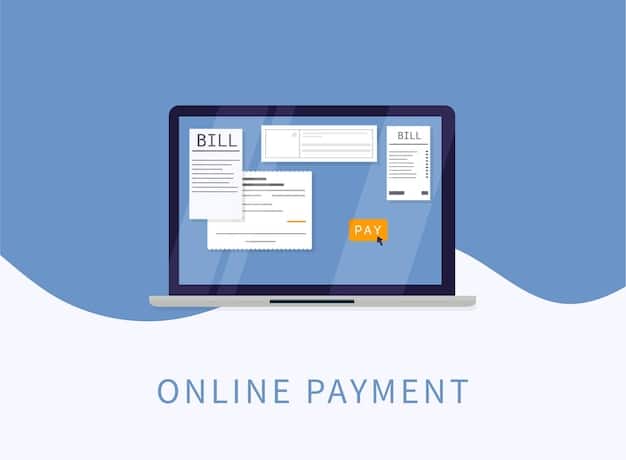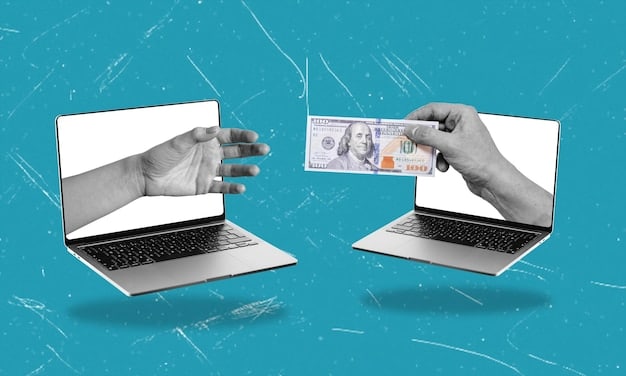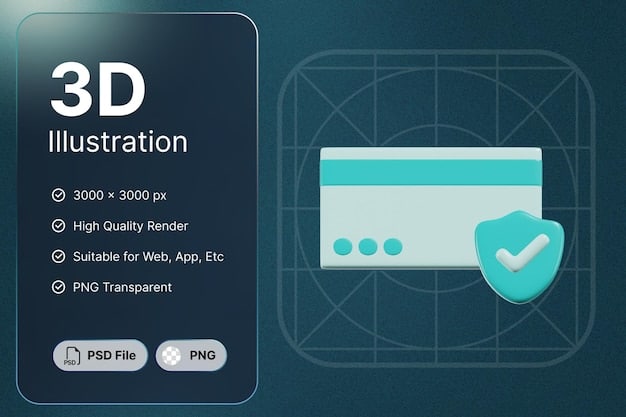Optimize Payment Page Design: Boost E-commerce Conversions in the US

Optimizing payment page design is crucial for US e-commerce businesses aiming to increase conversions. By implementing UI/UX best practices, such as simplifying the checkout process and enhancing trust signals, businesses can see an increase in conversions.
In the competitive US e-commerce landscape, a seamless payment experience can be the difference between a completed sale and an abandoned cart. Optimizing payment page design is not just about aesthetics; it’s a strategic move that directly impacts your conversion rates. Understanding the nuances of UI/UX within the payment process is essential for creating a user-friendly and trustworthy environment.
Are you ready to transform your payment page into a conversion powerhouse? Let’s explore some actionable UI/UX tips that can help US e-commerce businesses increase their conversions.
Why Optimizing Payment Page Design Matters for US E-commerce
The payment page is the final hurdle in the online shopping journey. It’s where customers make the ultimate decision to complete their purchase. A poorly designed payment page can lead to frustration, distrust, and ultimately, cart abandonment. For US e-commerce businesses, optimizing payment page design is critical for maintaining customer satisfaction and driving revenue growth. Let’s delve into why this aspect of your online store is so crucial.
Reducing Cart Abandonment Rates
Cart abandonment is a significant challenge for e-commerce businesses in the US. A complex or confusing payment page is a major contributor to this problem. By simplifying the checkout process and providing clear instructions, you can significantly reduce the number of customers who abandon their carts. This involves minimizing the number of steps required to complete a purchase and offering multiple payment options.
Building Trust and Credibility
Security is a top concern for online shoppers. Your payment page must instill confidence and reassure customers that their financial information is safe. Displaying security badges, using SSL encryption, and providing clear privacy policies can help build trust and credibility. Addressing these concerns proactively can improve your conversion rates and foster customer loyalty.
- Ensure your payment page has a valid SSL certificate.
- Display trust badges from reputable security companies.
- Clearly state your privacy policy and data protection measures.
A well-designed payment page not only secures transactions but also enhances the overall customer experience, leading to repeat purchases and positive word-of-mouth. Ignoring this critical step can result in lost sales and damage to your brand’s reputation.
Key UI/UX Tips for Optimizing Payment Page Design
Effective UI/UX design can transform your payment page from a source of friction into a seamless step in the customer journey. These tips, tailored for US e-commerce businesses, focus on creating a user-friendly and trustworthy payment experience. Below are some UI/UX strategies to consider when optimizing payment page design.

Simplify the Checkout Process
A lengthy and complicated checkout process is a major conversion killer. Minimize the number of fields required and streamline the steps to make it as easy as possible for customers to complete their purchase. Consider implementing a one-page checkout or a progress indicator to show customers how far they are in the process.
Offer Multiple Payment Options
Providing a variety of payment options caters to different customer preferences and can significantly increase conversions. Common payment methods in the US include credit cards, debit cards, PayPal, Apple Pay, and Google Pay. By offering more choices, you increase the likelihood that customers will find a convenient way to pay. Alternative payment methods should be available as well when optimizing payment page design.
Ensure Mobile Optimization
With the increasing number of online shoppers using mobile devices, it’s crucial to ensure your payment page is fully optimized for mobile. This includes using a responsive design that adapts to different screen sizes, optimizing images for mobile, and ensuring that form fields are easy to fill out on touchscreens.
By implementing these UI/UX tips, you can create a payment page that is not only visually appealing but also highly functional and user-friendly for optimizing payment page design.
Enhancing Trust and Security on Your Payment Page
In the realm of e-commerce, building and maintaining trust with your customers is paramount. This is especially true on the payment page, where sensitive financial information is exchanged. US consumers are particularly vigilant about online security, making it crucial to implement strategies that reassure them their transactions are safe. This section explores effective ways of optimizing payment page design to enhance trust and security.
Display Security Badges and SSL Certificates
Visibly displaying security badges from reputable companies like Norton, McAfee, or Trustwave can reassure customers that your payment page is secure. Additionally, ensuring your website has a valid SSL certificate is essential for encrypting data transmitted between the customer’s browser and your server. This not only protects their information but also boosts their confidence in your website.
Provide Clear Privacy Policies
Transparency regarding how customer data is collected, used, and protected is crucial for building trust. Clearly display your privacy policy and make it easily accessible from the payment page. Explain what information you collect, how you use it, and what measures you take to protect it. This transparency demonstrates your commitment to data security and privacy.
Offer Guest Checkout Options
Forcing customers to create an account before completing a purchase can deter some shoppers. Providing a guest checkout option allows them to complete their transaction without creating an account, reducing friction and increasing conversions. While encouraging account creation can be beneficial for future purchases, offering a guest option respects the customer’s choice and enhances their experience.
Prioritizing trust and security in your payment page design is not just about protecting your customers; it’s about establishing a long-term relationship built on confidence and reliability. With optimizing payment page design, conversions are sure to increase.

Mobile-First Approach to Payment Page Design
With the ever-increasing prevalence of mobile shopping, adopting a mobile-first approach to payment page design is no longer optional; it’s a necessity. US e-commerce businesses must ensure their payment pages are fully optimized for mobile devices to provide a seamless and user-friendly experience. A mobile-first approach ensures that all users, regardless of their device, can easily complete their purchase, thus optimizing payment page design.
Responsive Design and Layout
A responsive design adapts to different screen sizes and resolutions, providing an optimal viewing experience on any device. Ensure your payment page uses a responsive layout that automatically adjusts to fit the screen, whether it’s a smartphone, tablet, or desktop computer. This ensures that all elements of the payment page are easily visible and accessible, enhancing the user experience.
Optimized Form Fields and Input Methods
Filling out forms on mobile devices can be cumbersome, so it’s crucial to optimize form fields for touchscreens. Use large, easy-to-tap input fields and consider using auto-fill options to streamline the process. Additionally, offer different input methods like number pads for numeric fields and email keyboards for email addresses, making it easier for customers to enter their information accurately.
Simplified Navigation and Payment Options
Mobile users have limited screen space, so it’s essential to simplify navigation and payment options. Minimize the number of steps required to complete a purchase and offer mobile-friendly payment methods like Apple Pay and Google Pay. These payment options allow customers to pay quickly and easily with just a few taps, reducing friction and increasing conversions with optimizing payment page design.
A mobile-first approach to payment page design ensures that your e-commerce business is well-positioned to capture the growing mobile market. Prioritizing the mobile experience not only enhances customer satisfaction but also boosts your conversion rates and increases revenue.
A/B Testing and Continuous Improvement
Optimizing your payment page is not a one-time task; it’s an ongoing process of experimentation and refinement. A/B testing allows you to compare different versions of your payment page to see which performs better. By continuously testing and improving your payment page, you can identify areas for optimization and maximize your conversion rates and optimizing payment page design. Here’s why A/B testing is essential for optimizing your payment page.
Testing Different Layouts and Designs
Experiment with different layouts, colors, and designs to see which resonates best with your target audience. Test variations of your payment page with different placements of security badges, calls-to-action, and form fields. By comparing the performance of these variations, you can identify which design elements lead to higher conversions.
Analyzing User Behavior and Feedback
Use analytics tools to track user behavior on your payment page and identify drop-off points. Analyze heatmaps, session recordings, and user feedback to understand where customers are getting stuck or confused. This data can provide valuable insights into areas for improvement.
Implementing Changes Based on Results
Once you have gathered enough data from your A/B tests and user analysis, implement the changes that have proven to be effective. Continuously monitor the performance of your payment page and make further adjustments as needed. This iterative process of testing, analyzing, and implementing changes ensures that your payment page is always optimized for maximum conversions.
By embracing A/B testing and continuous improvement, you can stay ahead of the curve and ensure that your payment page remains a conversion-driving asset for your US e-commerce business. This method helps businesses be more effective with optimizing payment page design.
| Key Aspect | Brief Description |
|---|---|
| ⚡ Simplify Checkout | Minimize steps and fields for faster transactions. |
| 🔒 Enhance Security | Display trust badges and ensure SSL certificates. |
| 📱 Mobile Optimization | Ensure responsive design for seamless mobile experience. |
| 💰 Multiple Payment Options | Offer various methods like cards, PayPal, and digital wallets. |
Frequently Asked Questions
A well-designed payment page reduces cart abandonment by providing a seamless, trustworthy checkout experience, leading to increased conversions.
Key elements include a responsive design, optimized form fields, simplified navigation, and support for mobile payment options like Apple Pay and Google Pay.
Security badges from reputable companies signal to customers that their financial information is protected, building trust and reducing hesitation during checkout.
A/B testing involves comparing two versions of a payment page to see which performs better, allowing data-driven optimization based on user behavior and feedback.
US e-commerce sites should offer a variety of payment options, including credit cards, debit cards, PayPal, Apple Pay, Google Pay, and other popular digital wallets to cater to different customer preferences.
Conclusion
In conclusion, optimizing payment page design is essential for US e-commerce businesses aiming to boost conversions and enhance customer satisfaction. By implementing UI/UX best practices, prioritizing trust and security, and adopting a mobile-first approach, businesses can create a seamless checkout experience that drives revenue growth.
Remember, the payment page is the final step in the customer journey, and a well-designed payment page can make all the difference in turning potential customers into loyal buyers. Continuous improvement including optimizing payment page design will always be a good decision.





